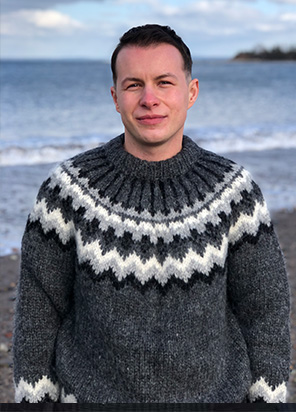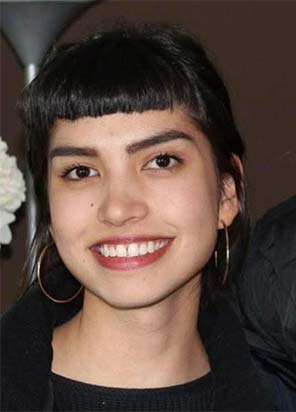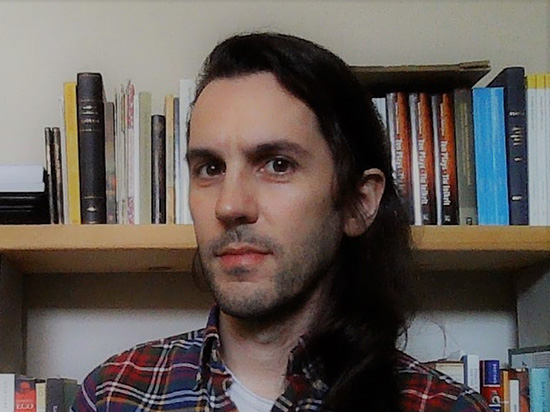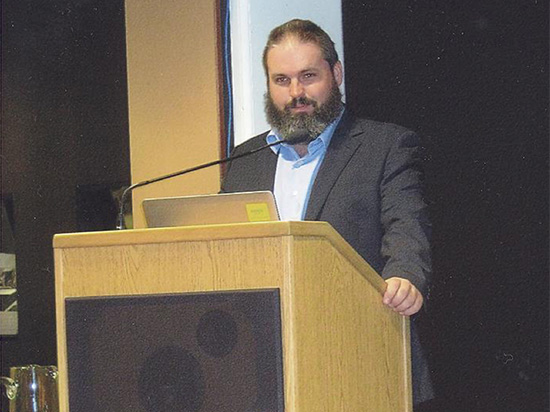 2025 Goodman Writers Grant Recipient: Jay Lalonde
2025 Goodman Writers Grant Recipient: Jay Lalonde
Support for a Groundbreaking History of Icelandic Settlers in Atlantic Canada
The Canada Iceland Foundation is pleased to announce that the 2025 Goodman Writers Grant, valued at $4,000, has been awarded to Jay Lalonde, a historian whose work is reshaping our understanding of Icelandic settlement in Atlantic Canada. This support will assist Jay in the publication of his forthcoming narrative non-fiction scholarly monograph, Markland: Icelandic Settlers in Nova Scotia and Atlantic Canada’s Immigration Policy, 1867–1885 (working title).
The Goodman Writers Grant is designed to help authors publish original work that strengthens the understanding of Icelandic history, heritage, and culture in North America. Jay’s project exemplifies this mission. Their book—now in its final dissertation stages at the University of New Brunswick—will be the first comprehensive history of the Icelandic settlement at Markland in Nova Scotia’s Musquodoboit Valley (1875–1882) and of the broader attempts to settle Icelanders in Atlantic Canada during the 1870s.
While Icelandic migration to the Canadian Prairies is widely known, the story of the Atlantic Canada settlement has been largely overlooked or reduced to passing mentions as “another failed colony.” Jay’s research challenges that narrative. Through meticulous archival work conducted across more than fifteen archives in Iceland, Canada, and North Dakota, they reconstructs the experiences of nearly 300 settlers who ventured east—many of whom preferred Nova Scotia or New Brunswick because of the climate’s similarity to Iceland and their expectation of more favourable agricultural land.
Jay’s work follows individuals such as district magistrate and widower Jón Rögnvaldsson, poet Halla Jónsdóttir, farmer Brynjólfur Brynjólfsson, merchant H. C. Robb, and the ambitious Icelandic immigration agent Jóhannes Arngrímsson (John Anderson). The book details not only their migration and settlement attempts but also the complex political landscape surrounding immigration, land policy, and provincial governance in the years following Confederation.
In addition to revising their dissertation into a book-length narrative, Jay will add at least two new chapters for the published monograph. One of these will explore the life and work of J. Magnús Bjarnason, an Icelandic-Canadian author who grew up in Markland and later fictionalized the community’s stories. Another will examine the relationships between Icelanders and the Mi’kmaq at the Beaver Dam reserve, considering how Nova Scotia’s reserve centralization policies intersected with immigration and settlement schemes.
A significant contribution of the project is the detailed appendix of biographies, which offers the first complete list of Icelandic settlers in Nova Scotia and provides genealogical, social, and geographic information of particular interest to descendants. Photographs, maps, land documents, settler letters, government correspondence, and oral histories further enrich the narrative.
With a projected word count of approximately 100,000 words plus appendices, Jay anticipates submitting the completed manuscript to an academic press following their dissertation defense in Spring 2026.
The Canada Iceland Foundation is proud to support this important contribution to Icelandic-Canadian scholarship. Jay’s work not only broadens our national historical understanding but also restores the voices, places, and experiences of a community whose story has long deserved a fuller telling.
Congratulations to Jay Lalonde, 2025 recipient of the Goodman Writers Grant.
We look forward to the publication of Markland and to the new insight it will bring to Icelandic and Canadian history.
 My Icelandic heritage has always played a major role in my life. My Amma lived in Gimli the majority of her life. She was such an animated storyteller - I loved hearing stories about when she was growing up, about my grandpa, dad and aunts, and extended family (stories that often had us howling in laughter) what the houses she lived in were like, her time working at Betel, war time food, anything. I was rapt. In addition to family stories, we bonded over a love of food and cooking. Every holiday season, amma, my aunts, my sister and I make vinarterta. We’ll make upwards of 20 sometimes—and if you’ve ever made vinarterta before, you know it’s a very laborious process— it truly is an ‘all hands on deck’ situation. We also have Hangikjöt and all the trimmings for Christmas Eve dinner. Though these connections may be small, they allow me to feel connected to my Icelandic side and keep my Amma’s spirit alive.
My Icelandic heritage has always played a major role in my life. My Amma lived in Gimli the majority of her life. She was such an animated storyteller - I loved hearing stories about when she was growing up, about my grandpa, dad and aunts, and extended family (stories that often had us howling in laughter) what the houses she lived in were like, her time working at Betel, war time food, anything. I was rapt. In addition to family stories, we bonded over a love of food and cooking. Every holiday season, amma, my aunts, my sister and I make vinarterta. We’ll make upwards of 20 sometimes—and if you’ve ever made vinarterta before, you know it’s a very laborious process— it truly is an ‘all hands on deck’ situation. We also have Hangikjöt and all the trimmings for Christmas Eve dinner. Though these connections may be small, they allow me to feel connected to my Icelandic side and keep my Amma’s spirit alive.
I graduated high school in 2012 and began taking courses at the University of Manitoba that fall. Although I had no idea what I wanted to pursue, I had a general sense that I would end up doing something in the arts. So, I did what any aimless novice student would do and enrolled in a bunch of different arts courses in the hopes that something would ‘stick’. This led me to sociology and criminology, where I would go on to complete my Bachelors of Arts (Honours) in criminology in 2017. During my undergrad, I became interested in the field of global criminology and worked with the late Dr. Russell Smandych on my honours thesis that explored the HIV/AIDS pandemic amongst female sex workers in sub-Saharan Africa. By examining the crisis through an intersectional global criminological feminist lens, I wanted to highlight how broader socio-cultural and economic conditions and processes (such as globalization, neoliberalism, sexism, racism, and colonialism) become embodied by female sex workers in sub-Saharan Africa, in the form of HIV/AIDS.
After graduating, I took two years off to do a bit of traveling, work, and plan out my next-steps. I enrolled in the Master of Arts program at the University of Manitoba in the fall of 2019–not knowing (as we do now, in retrospect) that the COVID-19 pandemic was looming around the corner. Initially, I had hoped to travel to Iceland to conduct interviews with newcomers to learn about their experiences immigrating to the country. Travel restrictions made this no longer feasible, so my committee and I pivoted. At the time, I was working as a research assistant for my internal committee advisor, Dr. Sonia Bookman in the sociology of brands and branding and Iceland’s tourism advertisements were garnering international attention. My research interests in nationalisms, mythologies, and spatial imaginaries led my committee and I to consider how Iceland’s branding strategies and representations of space/place in these ads might reproduce certain myths and imaginaries, which is what my thesis explores.
After a long journey, I defended my thesis this fall. I am grateful to my thesis committee for their ongoing support during the writing process and am especially indebted to my thesis advisor, Dr. Lori Wilkinson, for her wisdom, expertise, and guidance during my master’s program and in this next phase, as I re-work my thesis and prepare it for publication. A special thank you to the Canadian Icelandic Foundation for supporting my work.
www.cwecrocker.com
I was born in Corner Brook, Newfoundland, a town roughly 500 km south of the L’Anse aux Meadows national historic site. Despite growing up in relative proximity to the site, which is the only known location of Norse settlement in what is now North America, my interest in Old Norse-Icelandic literature began only after I completed my first university degree in mathematics. At the time, I was living and working along the west coast of Scotland where I became an avid reader in my off time. It was through the works of modern authors like William Vollmann and Halldór Laxness that I became interested in and began to search out works of Old Norse-Icelandic literature, at the time in English translation.
When I decided to return to Canada and to university, the presence of an Icelandic department at the University of Manitoba was an immediate draw. Although not initially my sole focus, the courses I took at the U of M in the Icelandic department, in both medieval and modern culture and literature, had a profound impact. So much so that, after a year of undergraduate course work, I entered a Master’s program in the department under the supervision of Professor Birna Bjarnadóttir. Modern Icelandic language courses with P.J. Buchan were also a crucial part of my program there. When it came time to develop a thesis project, Old Norse-Icelandic literature (and the Sagas about Early Icelanders in particular) was an obvious focal point.
During the final year of my program, I took part in the U of M’s Icelandic field school in Iceland, which led to a student exchange semester in Iceland. There, I audited courses in Old Norse language and medieval Icelandic literature and completed my dissertation on the representation of women in the sagas. I also met Professor Ármann Jakobsson who became my PhD supervisor at the University of Iceland. My dissertation project there focused on dreams in the sagas and was part of a larger project on Paranormal Encounters in medieval Iceland.
During and following my PhD program, I worked as an instructor in the Icelandic Department at the U of M, continued to conduct and publish my research on medieval Icelandic literature, and also co-translated Guttormur J. Guttormsson’s Ten Plays with Elin Thordarson. In 2018, I returned to the University of Iceland to work as a postdoctoral researcher in a large multidisciplinary project led by Professor Hanna Björg Sigurjónsdóttir. The project, titled “Disability before disability,” explored disability in Icelandic society, culture, and history before the establishment of disability as a modern legal, bureaucratic, and administrative concept.
For the past two years, I shifted focus by developing my own research project on the North American-Icelandic children’s newspaper Sólskin. My project centred around a large collection of children’s letters, including two written by a young Halldór Laxness, published in the paper in the 1910s. The project culminated with the publication of my book The Sunshine Children. In the meantime, I developed an outline to produce a book that continues my earlier research on the representation of disability in the medieval Icelandic sagas. The book will be a more comprehensive study of the topic, which I have previously written about in shorter articles and book chapters. I am grateful to the Canada Iceland Foundation for supporting my work.
Christopher is in the process of drafting the manuscript for publication.
 I first studied Old Norse Mythology under Professor Richard Harris at the University of Saskatchewan in the summer of 2002. His classes on Norse Mythology and Medieval Icelandic Literature were my favourite classes as an undergraduate, and I was able to capture my fascination with the topic in a term paper, “Loki: Potency of Chaos.” Later in graduate school I was able to study Old Norse Literature under Birna Bjarnadóttir and Icelandic Language under P.J. Buchan, at the University of Manitoba Department of Icelandic. My PhD in English Literature focused on Medievalism, examining how nineteenth- and twentieth-century writers, mainly in Iceland, the British Isles, and North America, rewrote medieval legends as a way of attempting to come to grips with the shocks and upheavals of modernity. Completing my PhD in 2016, I bicycled across Canada and came across a strange piece of graffiti near Moyie, British Columbia, which read simply LOKI, reminding me of this far-traveling and adaptable figure.
I first studied Old Norse Mythology under Professor Richard Harris at the University of Saskatchewan in the summer of 2002. His classes on Norse Mythology and Medieval Icelandic Literature were my favourite classes as an undergraduate, and I was able to capture my fascination with the topic in a term paper, “Loki: Potency of Chaos.” Later in graduate school I was able to study Old Norse Literature under Birna Bjarnadóttir and Icelandic Language under P.J. Buchan, at the University of Manitoba Department of Icelandic. My PhD in English Literature focused on Medievalism, examining how nineteenth- and twentieth-century writers, mainly in Iceland, the British Isles, and North America, rewrote medieval legends as a way of attempting to come to grips with the shocks and upheavals of modernity. Completing my PhD in 2016, I bicycled across Canada and came across a strange piece of graffiti near Moyie, British Columbia, which read simply LOKI, reminding me of this far-traveling and adaptable figure.
Since 2016 I have been teaching at the University of Manitoba, and it has been an honour to teach Old Norse Mythology and other classes for the Icelandic Department. I have also been preparing to write a book about Loki and his “international career” as one of the best-known figures of Norse Mythology during the last 50 years. In nineteenth-century poems, translations, and retellings, Loki was often vilified, partly as a result of the influence of nationalist ideals which in effect took his blood-brother Odin’s side in their feud, as Odin was seen as a founder of nations (moreover, Loki’s role as the slayer of the saintly god Baldr was interpreted as an almost devilish one). In the twentieth century, however, and especially since the 1970s (with Guðbergur Bergsson’s 1974 poem Flatey-Freyr as a milestone), many authors have been more sympathetic to Loki and have cast him in the role of creative patron, persecuted prophet, jaded anti-hero, defiant hero, or martyr for truth, a figure of worship and veneration; while the other gods of Asgard, and especially Odin, have more often been vilified for their empire-building and endless pursuit of war. Our religious, cultural, and indeed mythical, circumstances, now seem quite changed; but what does belief mean in an age of ongoing upheaval and rapid transformation? My title comes from Guðbergur Bergsson, who wrote: “Loki Is My God.”
Examining one of the most crucial, controversial, and inspiring figures from a body of literature which was written in Iceland and later communicated to the world, going on to inspire authors in numerous countries, will create a unique and poignant book that will appeal to anyone interested in Norse myth, Icelandic literature, Scandinavian cultural heritage and influence in the British Isles and North America, medievalism, folklore, and the living history of religion and culture. In times of ongoing catastrophe, the meaning of every stage of life may be interpreted by the fiery light of Ragnarok, an apocalyptic event in which Loki plays a definitive role. This dire catastrophe breaks the bonds of the trickster and of all beings, as history ends, foundations crumble, civilizations fall, and long-prophesied confrontations occur.
As a result of teaching (my article “Valhalla in Manitoba: An Icelandic Department Trip to New Iceland” will be published in the 2024 volume of Icelandic Connection shortly) and my own travels, I’ve also been visiting locations named after Norse mythical locations in western Canada (Gimli, Baldr, Ymir, Valhalla, etc.; this year I came across a “Loki Lane” is Kaslo, BC) and plan to draw on this experience, and to incorporate maps and illustrations into this book which will provide an overview of Loki’s story, mythical role, and reinterpretation in these strange times.
